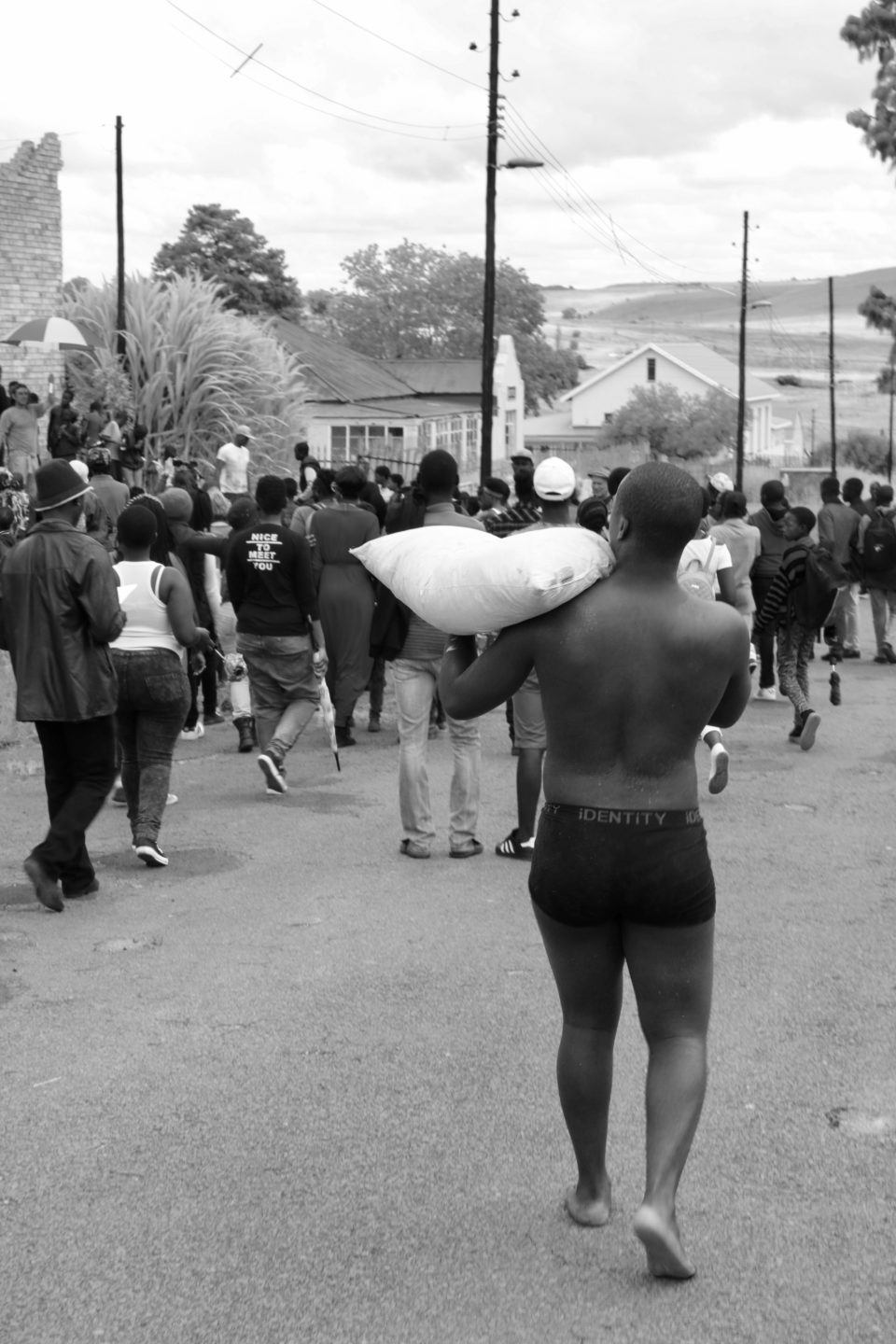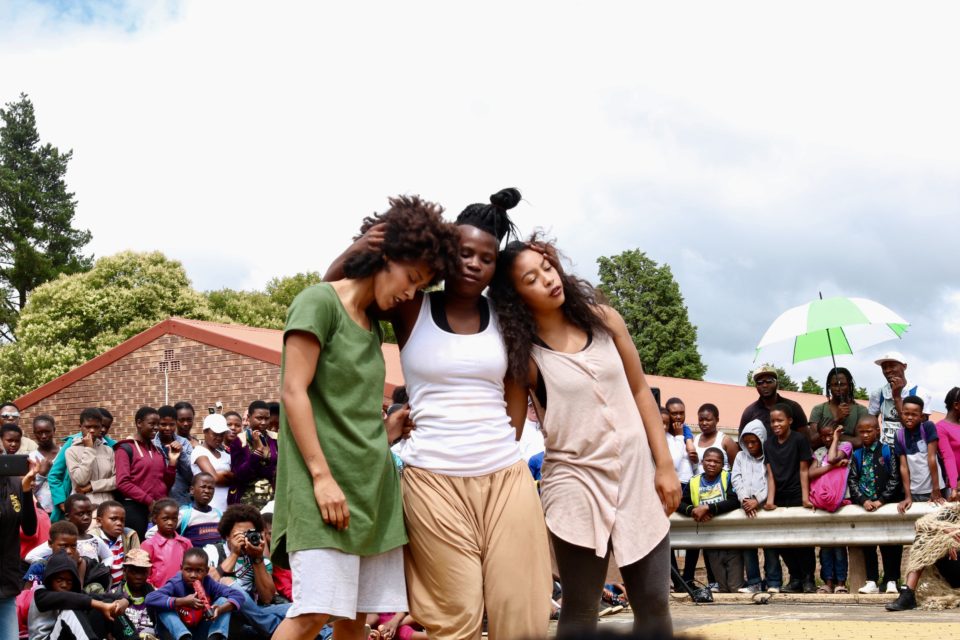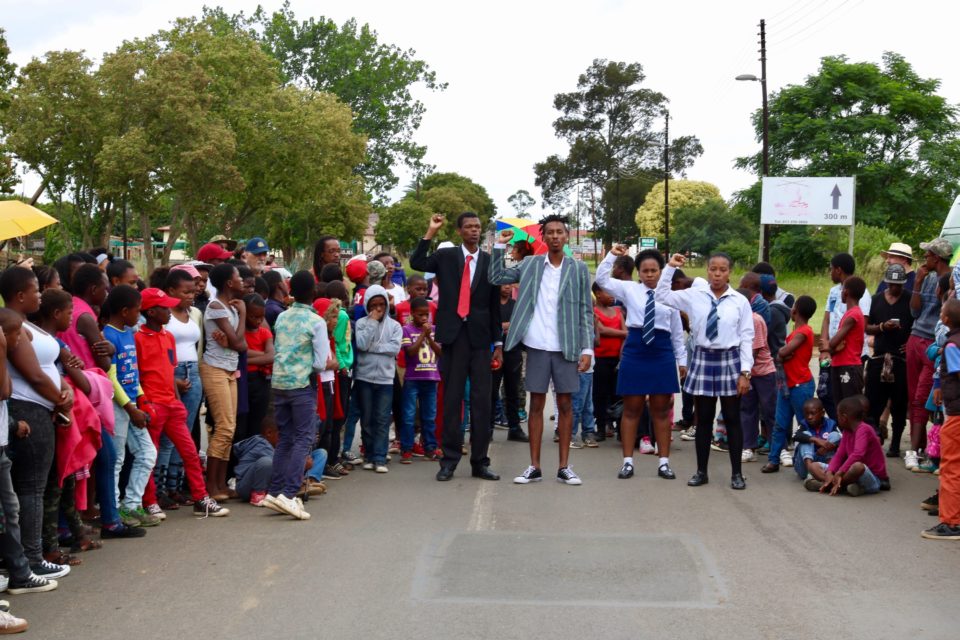Perhaps because of the glamour attached to them, we forget what sterile spaces stages are. The craft of a set designer or performer often involves transporting audiences: away from cavernous auditoriums to other, imagined places. This past weekend I attended an arts festival without stages or tickets or curtains — barely a delineation between audience, public, and performer. The My Body My Space Rural Arts and Culture Festival had as its stages school playgrounds, corner shops, pavements, trees, lawns, floating jetties. Even a pile of bricks became a platform for performance.
My Body My Space is a project of the Forgotten Angle Theatre Collaborative. Through dance theatre, its two artistic directors, PJ Sabbagha and Fana Tshabalala, have sought producing work that mines deep personal and social dilemmas.
By creating happenings in and around the streets of eNtokokweni, artists at this year’s festival forced audiences into new confrontations with the everyday. Seemingly-mundane objects, movements and spaces were re-presented to us in ways that sometimes rendered them magic, and at other times obscene. The familiar became strange again, prompting us to look at ourselves in new ways.

It was particularly apt, then, that the festival’s opening performance, choreographed by Fana Tschabalala, functioned in conversation with Njabulo Ndebele’s critically-acclaimed work: ‘Rediscovering the Ordinary’. A physical embodiment of the ‘impossible dialogue’ between blacks and whites in South Africa, the work unpacked spatial intimacies and conflicts, as bodies wrestled for recognition amidst a floor of empty cardboard boxes.
What might an artistic engagement with The Everyday mean for our politics, and indeed our humanity? The first lesson is in the festival’s location in rural Mpumalanga. It is often understood that life only happens in big cities, outside of which the world is stagnant and empty. By propelling us into encounters with apparently ‘barren’ spaces, My Body My Space challenged assumptions about where life, and art, and politics happen — and which bodies and spaces are made invisible when we turn away from ‘everyday happenings’ in ‘everyday places’.
For most South Africans, ‘politics’ is less about the power games of political parties, or accusations of state capture, and much more about the stuff of bare, ordinary life: toilets, food, schooling, sanitary pads, medicine. The great dramas of politics — of power, privilege, gender, race and brutality — unfold in the most quotidian places: the bedroom, the office, a public bathroom, a playground, or the back of a bakkie. These are also the places of some of our greatest personal achievements, intimacies and joys. Paying attention to the ordinary is about giving witness to the stories of others, and testimony to our own. In this way, the artists called upon a politics of recognition, calling our attention to that which is perverse or beautiful or transforming within ‘the ordinary’.

By re-appropriating everyday spaces for unintended purposes, artists at My Body My Space were engaged in subtle forms of resistance. Turning the street into a stage, they halted cars. Hitting branches together, trees became instruments. In one performance, a ripped feather pillow transformed into wings. And as the audience walked from one site to the next, artists breaking into performance among them, the delineations between life and art became increasingly unclear.
Just as much as ‘art imitates life’, so too can ‘life imitate art’. Art can teach us how to see, make sense of, use, or resist the spaces around us. One of the techniques used by artists of My Body My Space was to expose the extraordinary in the ordinary. By de-familiarising The Everyday, we were startled by practices that had once seemed so normal. Two performances used public over-consumption to provoke questions about everyday waste, covering their mouths and bodies with food and discarding the leftovers. Another young actor posed angry questions about water shortages in front of a hotel pool and its elaborate fountain.
But in addition to these stark political meanings, My Body My Space also offered transcendent human encounters. It put performers and their publics into spaces of shared vulnerability, where each regularly encroached on one another’s space. In this was the possibility to jolt, protect, step away from, and move towards one another. A striking metaphor about our relationships with others, both near and far. My Body My Space encouraged audiences to listen, to look, and to feel in places that we would usually, dismissively, pass by.




















































